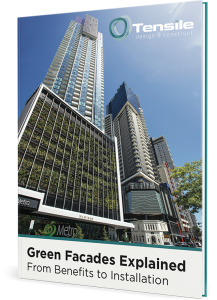Living walls and facades are well worth considering – they enhance the appeal of a building, help keep it cool, improve air quality and even increase biodiversity. But it’s also important to think about how long a green wall or facade will last.
Green walls can last a long time – maybe even as long as the building itself. But like any garden, they require good design as well as ongoing care and maintenance to do so.
We’ve put together a list of five key things that impact on the longevity of living walls and facades.
1. Climate and site characteristics
Climate and site characteristics should be assessed before starting the project, as this will have an impact on the design and how well the wall performs and lasts.
Considerations for this include local weather, seasons, rainfall, sun direction, micro-climate, building height, shadows, wind and light reflection.
2. A strong support structure
Materials such as timber or plastic might be fine for a home vertical garden. But for a multi-storey commercial green wall or facade, stainless steel is usually more suitable.
Stainless steel wire, rope or mesh are low-maintenance, robust, long-lasting materials ideal for green infrastructure. Wire rope, for example, provides strength combined with flexibility, enabling it to resist the impact of natural forces such as wind and movement.
3. Precision engineering
Green facades and walls can come under a lot of pressure from loads and natural forces. These include dead loads (weight of materials and plants) and transient loads (wind and movement), which can all put a strain on the building.
Accurate engineering helps ensure the system will go the distance. This should be undertaken by professional engineers experienced in green infrastructure for the greatest precision.
4. Plant selection
Some species of plants are more suited to green walls and facades than others, so it’s important to select the right plant types.
The plants selected for your wall also need to match the climate to thrive. For example, it would be pointless to put in tropical plants in a cool climate region!
Other considerations include how the light and nutrient needs of the plants, and how irrigation and drainage will be managed.
5. An ongoing maintenance plan
A maintenance plan should be incorporated into the design at the outset, as the plan may affect the design and vice versa.
Examples of maintenance tasks include weeding, mulching, pruning, waste removal, attending to plant health, plant replacement, and checking the support structure for wear. Site access for equipment and workers should be considered here.
Do you have a living wall project in mind? Get in touch with us to discover how we can assist.





































